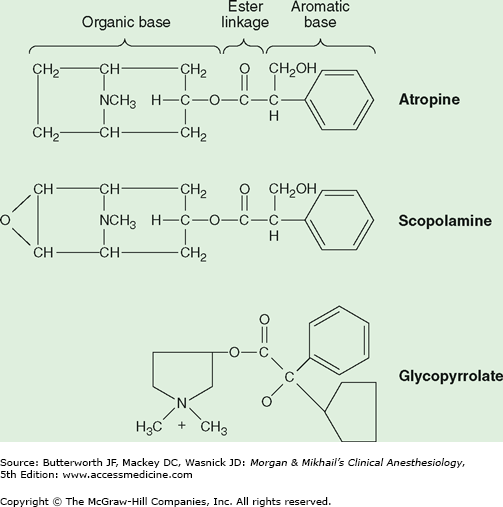Key Concepts
 The ester linkage is essential for effective binding of the anticholinergics to the acetylcholine receptors. This competitively blocks binding by acetylcholine and prevents receptor activation. The cellular effects of acetylcholine, which are mediated through second messengers, are inhibited.
The ester linkage is essential for effective binding of the anticholinergics to the acetylcholine receptors. This competitively blocks binding by acetylcholine and prevents receptor activation. The cellular effects of acetylcholine, which are mediated through second messengers, are inhibited.
 Anticholinergics relax the bronchial smooth musculature, which reduces airway resistance and increases anatomic dead space.
Anticholinergics relax the bronchial smooth musculature, which reduces airway resistance and increases anatomic dead space.
 Atropine has particularly potent effects on the heart and bronchial smooth muscle and is the most efficacious anticholinergic for treating bradyarrhythmias.
Atropine has particularly potent effects on the heart and bronchial smooth muscle and is the most efficacious anticholinergic for treating bradyarrhythmias.
 Ipratropium solution (0.5 mg in 2.5 mL) seems to be particularly effective in the treatment of acute chronic obstructive pulmonary disease when combined with a β-agonist drug (eg, albuterol).
Ipratropium solution (0.5 mg in 2.5 mL) seems to be particularly effective in the treatment of acute chronic obstructive pulmonary disease when combined with a β-agonist drug (eg, albuterol).
 Scopolamine is a more potent antisialagogue than atropine and causes greater central nervous system effects.
Scopolamine is a more potent antisialagogue than atropine and causes greater central nervous system effects.
 Because of its quaternary structure, glycopyrrolate cannot cross the blood-brain barrier and is almost devoid of central nervous system and ophthalmic activity.
Because of its quaternary structure, glycopyrrolate cannot cross the blood-brain barrier and is almost devoid of central nervous system and ophthalmic activity.
Anticholinergic Drugs: Introduction
One group of cholinergic antagonists has already been discussed: the nondepolarizing neuromuscular-blocking agents. These drugs act primarily at the nicotinic receptors in skeletal muscle. This chapter presents the pharmacology of drugs that block muscarinic receptors. Although the classification anticholinergic usually refers to this latter group, a more precise term would be antimuscarinic.
In this chapter, the mechanism of action and clinical pharmacology are introduced for three common anticholinergics: atropine, scopolamine, and glycopyrrolate. The clinical uses of these drugs in anesthesia relate to their effect on the cardiovascular, respiratory, cerebral, gastrointestinal, and other organ systems (Table 13-1).
Anticholinergics are esters of an aromatic acid combined with an organic base (Figure 13-1).  The ester linkage is essential for effective binding of the anticholinergics to the acetylcholine receptors. This competitively blocks binding by acetylcholine and prevents receptor activation. The cellular effects of acetylcholine, which are mediated through second messengers, are inhibited. The tissue receptors vary in their sensitivity to blockade. In fact, muscarinic receptors are not homogeneous, and receptor subgroups have been identified including: neuronal (M1), cardiac (M2), and glandular (M3) receptors.
The ester linkage is essential for effective binding of the anticholinergics to the acetylcholine receptors. This competitively blocks binding by acetylcholine and prevents receptor activation. The cellular effects of acetylcholine, which are mediated through second messengers, are inhibited. The tissue receptors vary in their sensitivity to blockade. In fact, muscarinic receptors are not homogeneous, and receptor subgroups have been identified including: neuronal (M1), cardiac (M2), and glandular (M3) receptors.
In normal clinical doses, only muscarinic receptors are blocked by the anticholinergic drugs discussed in this chapter. The extent of the anticholinergic effect depends on the degree of baseline vagal tone. Several organ systems are affected.
Blockade of muscarinic receptors in the sinoatrial node produces tachycardia. This effect is especially useful in reversing bradycardia due to vagal reflexes (eg, baroreceptor reflex, peritoneal traction, or oculocardiac reflex). A transient slowing of heart rate in response to smaller intravenous doses of atropine (<0.4 mg) has been reported. The mechanism of this paradoxical response is unclear. Facilitation of conduction through the atrioventricular node shortens the P-R interval on the electrocardiogram and often decreases heart block caused by vagal activity. Atrial arrhythmias and nodal (junctional) rhythms occasionally occur. Anticholinergics generally have little effect on ventricular function or peripheral vasculature because of the paucity of direct cholinergic innervation of these areas despite the presence of cholinergic receptors. Presynaptic muscarinic receptors on adrenergic nerve terminals are known to inhibit norepinephrine release, so muscarinic antagonists may modestly enhance sympathetic activity. Large doses of anticholinergic agents can result in dilation of cutaneous blood vessels (atropine flush).
Stay updated, free articles. Join our Telegram channel

Full access? Get Clinical Tree



